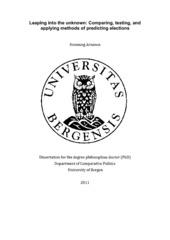| dc.description.abstract | The purpose of this dissertation is to compare, test, and apply methods of predicting election outcomes. It discusses the premises of the predictions and what kind of information is gathered and processed to form expectations about election results. It also elaborates on how making predictions can help us gain insights into voter trends and the causes of electoral outcomes. The first article, entitled Out of work and out of office: The golden mix for left bloc support, applies ex post predictions from an economic vote model in an effort to test the prevalence of economic voting in Norway. Across established democracies, the relationship between the economy and party choice is robust. In efforts to test the relationship further, forecasting models based on economic and political variables have been constructed for many democracies, most notably in France, the United Kingdom, and the United States. This work has produced an effective body of theory and empirical research on predicting election outcomes before they happen. However, for certain other democracies, such as Norway, little or no election forecasting has been carried out. The first dissertation article draws on established relationships from the economic voting literature and tests for their presence in Norwegian politics. I find that the left bloc’s vote share is sensitive to unemployment and whether or not they are in government. In line with the clientele hypothesis, the vote for the left has a positive relationship with unemployment figures. In addition, I find that being in office leads to a general depreciation of their vote share over time. The vote forecasting model constructed with these predictors is tested against and outperforms an AR(1) benchmark model for sequentially updated ex post prediction of the last ten Norwegian elections. The second article, entitled Information, motivation, prediction: An experiment with prediction markets during the 2009 Norwegian national election campaign, discusses the premises behind the formation of expectations about future election results, and what kind of information these expectations are based on. Most notably, this article present the very first experiments conducted with prediction markets in a Norwegian electoral context. The aims of the trials were to measure the accuracy of this prediction method in a multiparty context such as the one in Norway, to test the effect that monetary incentives have on the traders’ activities in a prediction market, and finally to compare how accurate prediction markets that consisted solely of active party members as traders were relative to the predictions made by “regular” prediction markets. Our results reveal that multiparty elections like the ones held in Norway are not an impediment to accurate predictions, that monetary incentives seem to bolster trading activity, and that active party members show signs of optimism bias when compared to markets with participants that were not active party members. The third and final article, entitled How prediction markets help us understand events’ impact on the vote in US presidential elections, argues that pre-election polls and prediction markets reflect two different processes that, when analyzed together, can help us understand if and how key events that occur during an election campaign influence the final outcome of the election. While polls can be seen as reflecting an enlightening process where voters come to realize their vote preferences, prediction markets naturally incorporate this process into their predictions. In the research behind this article, I study the movements of weekly poll ratings and IEM market predictions and measure the impact that selected events have on polls and predictions in the run up to the US 2004 and 2008 presidential elections. I conclude that the Swift Boat Veterans for Truth ad campaign in 2004 was an enlightening event that moved poll ratings in favor of President Bush – towards the level already predicted by the IEM market even before the swift boat event. The financial crisis in 2008, on the other hand, was an enlightened event. It came as news to both market traders and poll respondents, and effective sealed the victory for Obama. | en_US |
